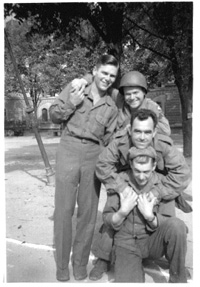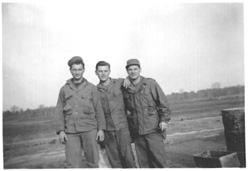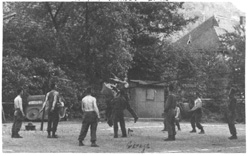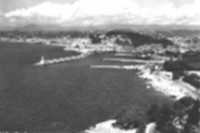(August 13, 1944 to May 8, 1945)
COMBAT OPERATIONS - 1945
On 16 January a move was made to Schieren in preparation for an attack across the Sauer River which occurred on the 18th. The attack was a slow stubborn fight and another move was not made until 21 January, to Erpeldange, and again about 4,000 yards Northward on the 23rd. From here the attack was supported to its limit, when defensive positions were again taken up near Schlindermanderscheid on 30 January. Two sections were moved forward to vicinity of Merscheid for harassing missions.
On 5 February the Fifth Division started reassembling for an attack across the Our River into Germany and positions were occupied North of Consdorf. Warmer weather had set in, a general thaw was in progress, and again much rain. Battery "C" 558th Field Artillery Battalion, was attached to the 191St FA Bn. The attack progressed slowly, the defenses and terrain were very difficult, and it was twelve days before a further displacement was possible. Germany was entered at 1003 on 17 February by the main column. Positions were occupied near Ferschweiler.
Another move was made to Freilingerhohe on the 20th and again on 26
February to Bettingen.
The
Fourth Armored Division began a break-through near Bitburg on March 4th
and the 5th Infantry Division followed. A rapid-moving action commenced
which continued until the 14th with successive positions at Pickliessen,
Oberkail, Manderscheid, and a long march to Landkern, near Kochen, on the
Moselle River.
The next action with the 4th Armored Division began on 15 March 1945, inside Germany. The Battalion was attached to 177th Field Artillery Group, and operated under Division Artillery control, which was this time working with Combat Command B. This force crossed the Mosselle River at Karden late on the 15th, and the Battalion reached a position area west of Simmern at 2130. During this move a tractor was hit after dark, passing thru a wooded area, by a German bazooka, and the driver seriously injured. The tractor, however, suffered only a hole in itís side, and the explosion of two smoke shells of itís load. One enemy plane strafed the area during the night, without damaging effect. Harassing fire was delivered on a town during the night.
Early the next morning the Combat Command moved on Bad Krueznach, the Battalion occupying positions near Huffelshiem. Enemy aircraft attacked the positions three times during the day, dropping one bomb about 50 yards from B Battery vehicles on one occasion, but without damage. After arriving is this area an enemy motor column started to pass along a road about 1000 yards away, but was too close to our troops for us to fire on. Tankers soon took them under fire, and destroyed approximately 50 of the vehicles. The Battalion fired 8 Harrassing and Interdiction missions during the night, and the following day fired 15 missions on towns, 4 preparation missions, 1 enemy barracks, and 2 vehicle concentrations, as Bad Krueznach was taken.
 On
the 18th positions near Frei-Laubersheim were occupied, and 7 Harassing
and Interdiction missions, 1 Self-propelled gun, 1 enemy battery, and 3
tanks were fired. Our observer, who fired the tank mission, reported 1
knocked out. Three preparation concentrations were also fired. On the 1
9th, 2 preparation missions, 12 TOTís on towns, 2 infantry concentrations,
1 artillery battery, 1 AA battery, and 1 tank concentration were fired
in support of our attack.
On
the 18th positions near Frei-Laubersheim were occupied, and 7 Harassing
and Interdiction missions, 1 Self-propelled gun, 1 enemy battery, and 3
tanks were fired. Our observer, who fired the tank mission, reported 1
knocked out. Three preparation concentrations were also fired. On the 1
9th, 2 preparation missions, 12 TOTís on towns, 2 infantry concentrations,
1 artillery battery, 1 AA battery, and 1 tank concentration were fired
in support of our attack.
The Combat Command moved out on Worms early on the morning of the 20th, and positions were occupied at Pfeddersheim that evening having fired 5 Harassing and Interdiction missions and 3 TOTís on towns. The next day the 177 Group moved North to support the Rhine crossing of the 5th Inf Div.
At 1900 on 24 March the Battalion crossed the Rhine at Oppenhiem with Combat Command B, incurring 3 casualties at the bridge site due to enemy air action. At 0225, after a 29 mile move behind German lines, a position near Huhlein was occupied, moving to Jugenheim at 0630. Again at 0830 the column moved out, and arrived near Aschaffenburg at 1525. We took 97 prisoners in this area.
 After
a move to Hausen, near Hanau, on the 27th, the Combat Command moved on
the 28th to Gobelnrod, and on the 29th to Lauterbach against scattered
resistance, overrunning fleeing German columns NW of the Main River. Only
Harassing and Interdiction missions were fired during this period, and
though we received several attacks by fighter planes, the only casualty
incurred was 1 man injured by our own AA.
After
a move to Hausen, near Hanau, on the 27th, the Combat Command moved on
the 28th to Gobelnrod, and on the 29th to Lauterbach against scattered
resistance, overrunning fleeing German columns NW of the Main River. Only
Harassing and Interdiction missions were fired during this period, and
though we received several attacks by fighter planes, the only casualty
incurred was 1 man injured by our own AA.
Hersfeld was attacked on March 30 and the following day we lost 1 man killed and two ¾ ton cars when they were attacked by an enemy tank at the western edge of the town. At 1430 on the 31st, the column moved out along the Autobahn, but was delayed for some time by a road block. During the halt C Battery took an AA battery under fire by direct laying, destroying all four sections. At 2025 positions were occupied near Hohnbach.
 Moving
out at 0630 1 April, we continued along the Autobahn. Near Wommern our
batteries received 20mm and machine gun fire from across the Werra River,
which attached AA guns silenced. Positions were occupied near Herleshausen,
and we fired on an enemy Observation Post, smoked an Observation Post and
destroyed an AA rocket battery east of Creuzburg. Later a move was made
to the vicinity of Ifta.
Moving
out at 0630 1 April, we continued along the Autobahn. Near Wommern our
batteries received 20mm and machine gun fire from across the Werra River,
which attached AA guns silenced. Positions were occupied near Herleshausen,
and we fired on an enemy Observation Post, smoked an Observation Post and
destroyed an AA rocket battery east of Creuzburg. Later a move was made
to the vicinity of Ifta.
The next morning our positions were attacked by enemy fighter bombers in considerable strength, one flight of 50 FW 190s was particularly aggressive, but we received only one light casualty. At dusk the Werra was crossed at Creuzburg to positions preparatory to moving east the following morning.
On 3 April Combat Command B attacked Gotha, the Battalion arriving in area 1 mile North of the town at 1310. Again fighter bombers were active the area; we received 1 casualty from bombs. Our positions were at the edge of an airfield which the enemy had just vacated. Our observers spotted another field with planes still on the ground east of Gotha, and we destroyed 1 two motor bomber, 1 fighter plane, and damaged 6 fighters by our fire.
The next day Combat Command B moved to support an attack on Ohrdruf, the Battalion moving to Muhlberg in column. While moving up the Assistant S ó 3 spotted a train moving east toward Arnstadt, and Battery A dropped off a section which fired on the train at 5000 yards using direct laying. The train was hit and the locomotive destroyed. Later 4 other trains which had pulled into Arnstadt were fired on and damaged.
 On
6 April, the Battalion moved to Schwabhausen with the Combat Command, and
later passed to the control of the VIII Corps, attached to 174th Field
Artillery Group.
On
6 April, the Battalion moved to Schwabhausen with the Combat Command, and
later passed to the control of the VIII Corps, attached to 174th Field
Artillery Group.
On the 6th the Battalion moved through Wechmar and went into position at Schwabhausen; with the return of our Liaison Officer from the XII Corps came the notification that this organization was relieved of attachment to that Corps and reattached to VIII Corps and Fourth Armored Division effective the 4th of April. The Battalion was further attached to the 174th Field Artillery Group. On the 7th the notorious Concentration Camp at Ohrdruf was visited by many in the Battalion.
The Battalion was in position at Dienstadt on the 14th. Following this rapid series of displacements Kahla was entered by the 191st Field Artillery Battalion on the 15th where the Saale River was crossed. Clearing the town of Hummelshain the Battalion arrived in position 1½ mile South of Zwickau. On the 17th the Battalion passed through Greiz and established its CP at Oberneumark and on the 18th retraced a previous march from Leubnitz to Altenberg to enter Munsa and Rochlitz, a march of 67 miles, to go into position 11/2 miles SE of Kl Stadten. Here the Battalion received the mission of General Support of the Sixth Armored Division. According to Troop Assignment No. 104, Headquarters 12th Army Group, this Battalion was assigned to the 1st Army.
 The
CP was established at Narsdorf on the z4th, passing through the towns of
Wiederau, Cossen and Hohenkirchen. Another long road march of 104 miles
was made on the 27th and 28th to join the 1st Infantry Division near SeIb.
The Battalionís mission was to reinforce the fires of the 7th Field Artillery
Battalion. The CP was established at Selb.
The
CP was established at Narsdorf on the z4th, passing through the towns of
Wiederau, Cossen and Hohenkirchen. Another long road march of 104 miles
was made on the 27th and 28th to join the 1st Infantry Division near SeIb.
The Battalionís mission was to reinforce the fires of the 7th Field Artillery
Battalion. The CP was established at Selb.
Czechoslovakia was entered by the Battalion on the 29th at Asch and the CP was established at Lindau.
5 casualties were suffered by the Battalion on the 30th due to mines.
On 2 May the Battalion moved to Unt Triebel, Germany and was assigned the mission of reinforcing the fires of the 253rd Armored Field Artillery Battalion. The 253rd Armd FA Bn was in direct support of the 6th Cavalry Group.
The Battalion fired in support of the 6th Cavalry Group in its attack
of 6 May. This attack was called off 7 May and on that date the Battalion
was notified of the unconditional surrender of Germany.
The book, "History and Operations of the 191st Field Artillery Battalion" ends on May 7th, 1945.
A typed page "Travels of the 191st Field Artillery BN" lists the following additional entries:
2 May, 45 - Unt Triehol, Germany (War ended here 8, May 0241)
4 May, 45 - Unt Triebell, Germany (After VE Day)
8 May, 45 - Reichembach, Germany
11 May, 1945 - Haltzenroda, Germany
12 May - Rhula German (Began Mil. Gov't)
22 June, 45 - Eisenach, Germany
(Sometime during my father's stay in Germany he visited Berchtesgarden)
The following entries were hand written by my father:
28 Sept. 45 - Straubing, Germany - Left 6: P.M. for Camp Chicag0,
France

Nice |

Nice |

Villefranche |
22 Nov. 45 - Left Marsailles, France for home
(Author's note: the ship my father sailed home on was not identified. However, the following website lists a troopship leaving Marsailles that day as the SS Hermitage: http://hometown.aol.com/troopship/shipli45.htm)
3 Dec. 45 - Arrived at Camp Shanks, New York
9 Dec. - Out of Army at 1:35 at Fort Levenworth, Kansas.